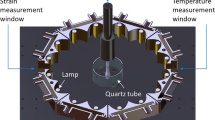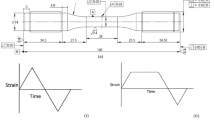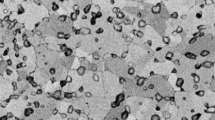Abstract
Thermomechanical fatigue (TMF) tests are carried out in order to characterize the behavior of turbine blades and vanesmaterials: superalloys. These materials suffer high stress levels at very high temperature and to simulate these extreme operation conditions a test-piece is subjected to controlled thermal and mechanical strain waveforms. In this paper, a test procedure is explained, which is unusual due to the fact that the heating system is based on direct resistance method and temperature is controlled by means of a pyrometer. For this purpose, emissivity evolution was studied. The effectiveness of the method, as well as some other important aspects such as alignment and a proper thermal–mechanical strain decoupling are discussed. Finally, some preliminary results of the cyclic behavior and life prediction of C-1023 nickel base superalloy are introduced. This also includes an analysis of specimens fractography.
Similar content being viewed by others
References
Neu, R.W., and Sehitoglu, H., “Thermomechanical Fatigue, Oxidation and Creep: Part I-Damage Mechanisms,” Metallurgical Transaction 20A: 1755–1767 (1989).
Neu, R.W., and Sehitoglu, H., “Thermomechanical Fatigue, Oxidation and Creep: Part II-Life Predictions,” Metallurgical Transaction 20A: 1769–1781 (1989).
Sehitoglu, H., “Thermomechanical-Fatigue Life Prediction Methods,” Advances in Fatigue Lifetime Predictive Techniques, ASTM STP 1122: 44–76 (1992).
Sehitoglu, H., and Boismier, D.A., “Thermomechanical Fatigue of Mar-M247: Part2-Life Prediction,” Journal of Engineering Materials and Technology 112: 80–90 (1990).
Miller, M.P., McDowell, D.L., Oehmke, R.L.T., and Antolovich, S.D., “Life Prediction Model for Thermomechanical Fatigue Based on Microcrack Propagation,” ThermomechanicalFatigue Behaviour of Materials, ASTM STP 1186: 35–49 (1993).
Reuchet, J., and Remy, L., “Fatigue Oxidation Interaction in a Superalloy-Application to Life Prediction in High Temperature Low Cycle Fatigue,” Metallurgical and Materials Transactions 14A: 141–149 (1983).
Bernstein, H., “An Evaluation of Four Creep-Fatigue Models for a Nickel-Based Superalloy,” Low-Cycle Fatigue and Life Prediction, ASTM STP 770: 105–134 (1982).
Nissley, D.M., “Thermomechanical Fatigue Life Prediction in Gas Turbine Superalloys: A Fracture Mechanics Approach,” American Institute of Aeronautics and Astronautics Journal 33: 1114–1120 (1995).
Bernstein, H.L., Grant, T.S., McClung, R.C., and Allen, J.M., “Prediction of Thermal-Mechanical Fatigue Life for Gas Turbine Blades in Electric Power Generation,” Thermomechanical Fatigue Behaviour of Materials, ASTM, STP 1186: 212–238 (1993).
Ostergren, W.J., “A Damage Function and Associated Failure Equations for Predicting Hold Time and Frequency Effects in Elevated Temperature, Low Cycle Fatigue,” Journal of Testing and Evaluation 4: 327–339 (1976).
Zamrik, S.Y., and Renauld, “Thermo-mechanical Out-of-Phase Fatigue Life of Overlay Coated IN738-LC Gas Turbine Material,” Thermomechanical Fatigue Behavior of Materials, ASTM, STP 1371: 119–135 (2000).
Smith, K.N., Watson, P., and Topper, T.H., “A Stress–strain Function for the Fatigue of Metals,” Journal of Materials 5(4): 767–780 (1970).
Pahlavanyali, S., Rayment, A., Roebuck, B., Drew, G., and Rae, C.M.F., “Thermo-Mechanical Fatigue Testing of Superalloys Using Miniature Specimens,” International Journal of Fatigue 30(2): 397–403 (2008).
H¨ahner, P., Affeldt, E., Beck, T. et al., Validated Code-of-Practice for Strain-Controlled Thermo-Mechanical Fatigue Testing. Joint Research Centre. The Netherlands (2006).
Beck, T., and Rau, K., “Temperature Measurement and Control Methods in TMF Testing – A Comparison and Evaluation,” International Journal of Fatigue 30: 226–233 (2008).
Evans, W.J., Screech, J.E., and Williams, S.J., “Thermo-Mechanical Fatigue and Fracture of INCO718,” International Journal of Fatigue 30: 257–267 (2008).
ASTM E 2368–04, Standard Practised for Strain Controlled Thermomechanical Fatigue Testing, American Society for Testing and Materials, Philadelphia, PA (2005).
Kuhn, H., and Medlin, D., ASM Handbook, Mechanical testing and evaluation, Volume 8, OH, pp. 1582–1593 (2000).
Kandil, F.A., and Dyson, B.F., “Influence of Load Misalignment During Fatigue Testing I and II,”Fatigue and Fracture of Engineering Materials and Structures 16(5) (1999).
ASTM E 1012–99, Standard Practice for Verification of Specimen Alignment Under Tensile Loading, American Society for Testing and Materials, Philadelphia, PA (1999).
VAMAS, Recent Intercomparisons on Low Cycle Fatigue and Alignment Measurements. Report No. 41. ISSN 1016–2186.UK (2003).
Greene, G.A., Finfrock, C.C., and Irvine, T.F., Jr., “Total Hemispherical Emissivity of Oxidized Inconel 718 in the Temperature Range 300-1000°C,” Experimental Thermal and Fluid Science 22: 145–153 (2000).
García de la Yedra, A., Martín-Meizoso, A., and Pedrejón, J.L., “Thermomechanical Fatigue Tests on MarM-247 Superalloy Using Direct Resistance Method,” Materials at High Temperature Journal 30(1): 19–26 (2012).
Huang, Z.W., Wang, Z.G., Zhu, S.J., Yuan, F.H., and Wang, F.G., “Thermo-Mechanical Fatigue Behaviour and Life Prediction of a Cast Nickel-Based Superalloy,” Materials Science and Engineering A 432: 308–316 (2006).
Acknowledgments
Thanks are given to ITP (Spain) for its financial support and materials; to the Spanish Ministry of Science and Innovation for the financial support (project MAT2008-03735/MAT) and to the Basque Government (project PI09-09). AGY would also like to thank Asociación de Amigos de la Universidad de Navarra for the received fellowship.
Author information
Authors and Affiliations
Corresponding author
Rights and permissions
About this article
Cite this article
de la Yedra, A.G., Pedrejón, J.L., Martín-Meizoso, A. et al. Thermomechanical Fatigue Tests Development and Life Prediction of a Nickel Base Superalloy. Exp Tech 40, 777–787 (2016). https://doi.org/10.1007/s40799-016-0078-9
Published:
Issue Date:
DOI: https://doi.org/10.1007/s40799-016-0078-9




